Fig. 22.1
Phototoxic reaction after harvesting parsnips on a sunny day
Children playing outdoors and scantily clad gardeners operating string trimming tools are especially at risk. Careful history and examination can usually distinguish phototoxic from allergic reactions to plants (Table 22.1). Members of the Apiaceae (Umbelliferae) family, including food plants such as parsnip, celery and parsley, as well as common wildflowers such as Heracleum spp. (Fig. 22.2) are common culprits.
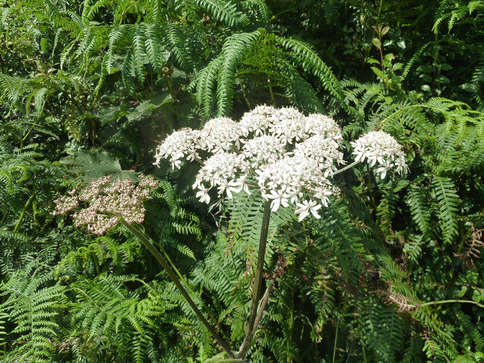
Table 22.1
Distinction between phototoxic and allergic reactions to plants
Phototoxic | Allergic |
|---|---|
All lesions present simultaneously | Lesions may gradually evolve over hours/days |
Sharply demarcated | Often less clearly demarcated |
Restricted to areas of sun exposure | Not restricted to areas of sun exposure |
Typically streaky, vesicular or bullous | Often streaky, erythematous, may be vesicular or bullous |
Often painful | Pruritic |
Followed by hyperpigmentation, which may persist for several months | Minimal, if any, hyperpigmentation |
No scaling | Scaling during resolution |
Commoner in children at play | Commoner in adults |
Often a single episode | May be a history of recurrent episodes, sometimes worsening with each episode |

Fig. 22.2
Heracleum sphondylium, a phototoxic member of the Apiaceae
Other plant families containing phototoxic species are Moraceae (fruiting figs) and Rutaceae, including Ruta (rue) (Fig. 22.3), Dictamnus (burning bush) and citrus fruit, notably limes. Phototoxicity can occur in any individual; it does not represent an idiosyncratic response to the plant, and patch testing is not helpful. Prevention includes identification of potentially phototoxic plants and adequate photoprotection against UVA when coming into contact with them. For example, rue should not be planted near a swimming pool or on a sun terrace.
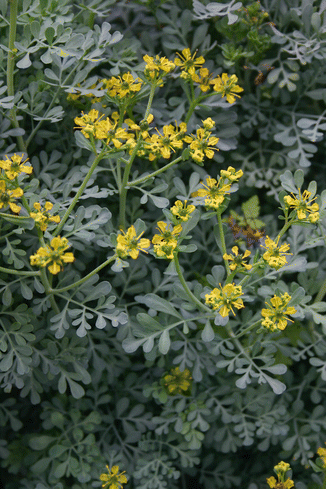

Fig. 22.3
Ruta graveolens (rue)
Immediate hypersensitivity may present as urticarial lesions, conjunctivitis, rhinitis, bronchospasm or even anaphylaxis. Grass and tree pollens are often implicated in asthma and hay fever. Vegetables are an important cause of contact urticaria and protein contact dermatitis in food handlers [8]. Skin prick testing with fresh produce is preferable to reliance on commercial extracts as antigens can be destroyed or modified by processing [8].
This chapter concentrates on delayed hypersensitivity (allergic contact dermatitis), caused by plants or plant products. Although nearly 19,000 plant species may be implicated in allergic contact dermatitis [5], most commonly encountered culprits belong to a small number of plant families (listed in bold type in Table 22.2). The major chemical groups of allergens implicated in plant dermatitis are listed in Table 22.3 [9]. Many allergenic plants are also irritant. As with other allergens, extensive exposure, e.g. pruning or removing dead leaves, increases the risk of becoming sensitised. Thus, a greenhouse worker handling large numbers of specimens may become sensitised to a plant which is generally a low risk to the casual grower.
Table 22.2
Allergenic plant families
Anacardiaceae (poison ivy/oak, etc.) |
Asteraceae (Compositae) daisy family |
Primulaceae (Primula obconica) |
Araliaceae (ivy) |
Lamiaceae (lavender, rosemary, thyme, mint) |
Alstroemeriaceae (Alstroemeria) |
Alliaceae (garlic, onion, shallot) |
Jubulaceae (liverworts, e.g. Frullania) |
Apiaceae (carrots, celery) |
Myrtaceae (tea tree, eucalyptus) |
Ginkgoaceae (Ginkgo) |
Hydrophyllaceae (Phacelia, Eriodictyon) |
Orchidaceae (Vanilla, Paphiopedilum) |
Simaroubaceae (tree of heaven (Ailanthus)) |
Tropical hardwood families, including Leguminosae, Ebenaceae, Sapotaceae |
Cupressaceae and Pinaceae (conifers) |
Graminae (grasses, cereals) |
Lichens |
Table 22.3
Important allergens in the plant kingdom
α-Methylene γ-butyrolactones |
Sesquiterpene lactones in Asteraceae (Compositae), Liverworts, e.g. Frullania (Jubulaceae), Magnolia (Magnoliaceae) |
Tuliposide A (hydrolysed to α-methylene γ-butyrolactone plus glucose) in Alstroemeria, Tulipa |
Quinones |
In Primula, Phacelia, Eriodictyon, tropical hardwoods |
Phenol derivatives |
In Rhus (Toxicodendron) |
Terpenoids |
In Lavandula (lavender, Lamiaceae), Citrus (Rutaceae), tea tree (Melaleuca, Myrtaceae) |
Miscellaneous |
Disulphides, in garlic, onion (Allium spp.) |
Isothiocyanates, in mustard oil (Brassica nigra, Brassicaceae) |
Polyacetylene derivatives, e.g. falcarinol in ivy (Hedera helix) |
22.3 Major Plant Families Which Cause Allergic Contact Dermatitis (Table 22.2) [2–5]
22.3.1 Anacardiaceae (Figs. 22.4 and 22.5)
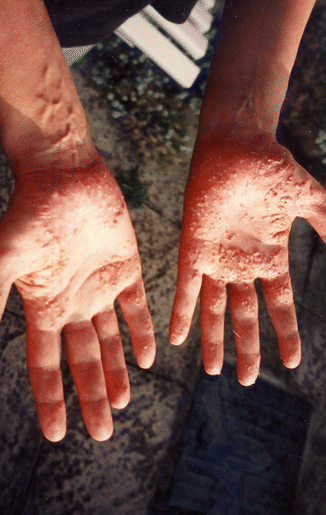
Fig. 22.4
Vesicular allergic contact dermatitis after handling poison ivy
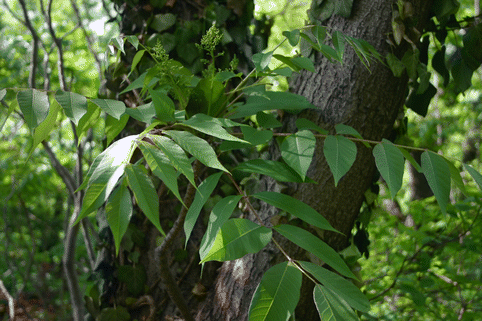
Fig. 22.5
Rhus (Toxicodendron) succedaneum, an allergenic member of the Anacardiaceae
Poison ivy and poison oak (Rhus spp.) are major causes of allergic dermatitis in the USA, but rare in western Europe, although occasional outbreaks are attributed to the Japanese lacquer tree (Rhus verniciflua), planted as an ornamental. This family is an important cause of dermatitis worldwide, including mango (Mangifera indica) in the tropics, cashew nut tree (Anacardium occidentale) and marking nut tree (Semecarpus anacardium) in India and Smodingium argutum in Southern Africa. Allergic reactions present typically as a florid vesiculobullous dermatitis, often in streaks, affecting the face, limbs and sometimes genitalia. Black specks of oxidised urushiol may be found on skin or clothes. Patch testing with these plants or their allergens (pentadecylcatechols) carries a high risk of active sensitisation and should be avoided.
22.3.2 Asteraceae (Compositae)
Members of this huge family (over 20,000 species) are the commonest causes of plant dermatitis reports worldwide. It includes ornamental plants such as the florist’s chrysanthemum (Dendranthema cvs.), vegetables and herbs and native and introduced weeds, such as Parthenium hysterophorus in India and Africa. Dermatitis may initially affect the hands, but an airborne pattern is characteristic, mimicking photosensitivity but affecting skin folds and areas shielded from sunlight (Fig. 22.6). Photoallergy to Asteraceae rarely, if ever, occurs; however, secondary photosensitivity (chronic actinic dermatitis) may follow repeated episodes of airborne antigenic challenge from material shed from the surface of the plants.
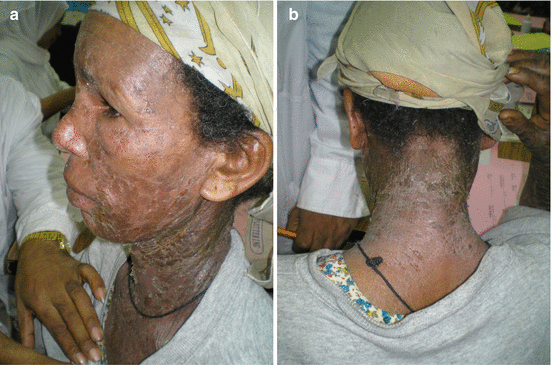

Fig. 22.6
(a, b) Allergic contact dermatitis to Asteraceae (Compositae) in an Ethiopian farmer
Together with Anacardiaceae, Asteraceae may cause systemic contact dermatitis after ingestion of material to which the individual has been previously sensitised by contact. Feverfew, taken orally for migraine, is an example. This resembles the “baboon syndrome” or Systemic Drug-Related Intertriginous and Flexural Exanthema (SDRIFE) caused by drugs [10].
There are over 5,000 sesquiterpene lactones, the terpenoids responsible for Asteraceae contact dermatitis. The “sesquiterpene lactone mix”, comprising three pure chemicals, costunolide, dehydrocostus lactone and alantolactone, has traditionally been used as a screen for Asteraceae allergy [11]. Active sensitisation is rare with this mix, but it only detects around 30–35 % of allergic patients [12]. Additional patch testing with parthenolide, with careful addition of extracts of locally important Asteraceae, increases the sensitivity [13]. The compositae mix [14] is comprised of ether extracts of five wild plants (Table 22.4); it detects more patients but carries a higher risk of active sensitisation and can give false-positive irritant reactions in higher concentrations. Furthermore, the potential variability of chemical constituents in wild populations of these plants can affect the reproducibility of such a mix. The 6 % mix devised by Hausen elicits more positive reactions than the 5 % mix currently available commercially [13]. Recently a modified sesquiterpene lactone mix has been proposed, which better reflects the structural range of different sesquiterpene lactones and may prove to be a more sensitive testing material [15].
6 % pet |
Tanacetum parthenium (feverfew) extract 1 % |
Tanacetum vulgare (tansy) extract 1 % |
Chamomilla recutita (German chamomile) extract 2.5 % |
Achillea millefolium (yarrow) extract 1 % |
Arnica montana (arnica) extract 0.5 % |
5 % pet |
Parthenolide 0.1 % |
Tanacetum vulgare extract 1 % |
Chamaemelum nobile (Roman chamomile) extract 2.4 % |
Achillea millefolium extract 1 % |
Arnica montana extract 0.5 % |
22.3.3 Primulaceae
The classical streaky eruption on the forearms from handling Primula obconica is now rare, since the development of “hypoallergenic” cultivars which contain less primin [16]. Primin, a quinone, is the principal allergen, although miconidin can also sensitise [17]. In common with dermatitis induced by other quinones, primin may induce an erythema multiforme – like eruption. Primin appears not to be responsible for the dermatitis induced by hardy Primula species in alpine gardeners [18].
Stay updated, free articles. Join our Telegram channel

Full access? Get Clinical Tree







